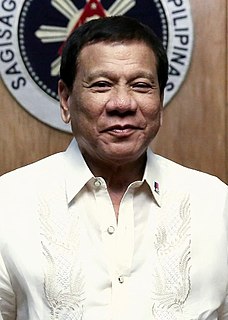
Baguio, officially the City of Baguio and popularly referred to as Baguio City, is a city in the mountainous area of the Northern Luzon, Philippines. It is known as the Summer Capital of the Philippines, owing to its cool climate since the city is located approximately 4,810 feet above mean sea level, often cited as 1,540 meters in the Luzon tropical pine forests ecoregion, which also makes it conducive for the growth of mossy plants, orchids and pine trees, to which it attributes its other moniker as the "City of Pines".
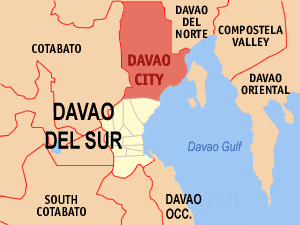
Davao City, officially the City of Davao, is a 1st class highly urbanized city in the island of Mindanao, Philippines. The city has a total land area of 2,443.61 km2 (943.48 sq mi), making it the largest city in the Philippines in terms of land area. It is the third-most populous city in the Philippines after Quezon City and Manila, the most populous city in the country outside Metro Manila, and the most populous in Mindanao. As of the 2015 census, the city had a population of 1,632,991.

Clark International Airport, is an airport that is an international gateway to the Philippines within Clark Freeport Zone in Angeles and Mabalacat, located 43.2 NM northwest of Manila. The airport is located in the province of Pampanga and is accessible through the Subic–Clark–Tarlac Expressway which is connected to the North Luzon Expressway. Clark International Airport is an airport located in the province of Pampanga situated north of Manila via EDSA to North Luzon Expressway & Subic-Clark-Tarlac Expressway and south of Baguio City via Tarlac-Pangasinan-La Union Expressway to Subic-Clark-Tarlac Expressway in Clark, Pampanga.
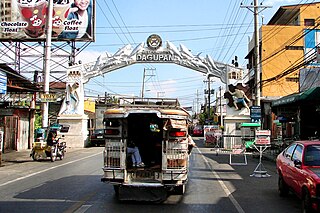
Dagupan, officially the City of Dagupan, or simply Dagupan City, is a 1st Class independent component city in the province of Pangasinan, Philippines. According to the 2015 census, it has a population of 171,271 people.
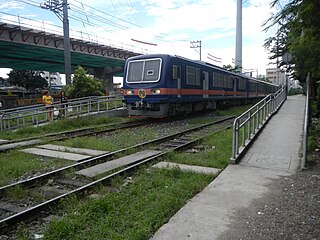
Rail transportation in the Philippines presently is used mostly to transport passengers within Metro Manila and the nearby province of Laguna. Freight transport is nonexistent, although there are plans for a revival from Port Area, Manila to Laguna, and a cargo train planned between Subic and Clark. Currently, the country has a railway footprint of only 109 kilometers (68 mi) through Line 1, Line 2, Line 3 and the Philippine National Railways' (PNR) Metro Commuter Line, although the government has stated to expand the network to 244 kilometers (152 mi) in Luzon, as well as building the 102 km (63 mi) first phase of the 1,550 kilometers (960 mi) Mindanao Railway expansion.
The Legislative district of Baguio is the representation of the highly urbanized city of Baguio in the various national legislatures of the Philippines. The city is currently represented in the lower house of the Congress of the Philippines through its lone congressional district.

The Dr. Jose N. Rodriguez Memorial Hospital (DJNRMH), formerly known as Central Luzon Sanitarium, was established in 1940, to accommodate patients suffering from Hansen's Disease in the entire Luzon region in the Philippines. It is currently situated within the district of Tala, in Caloocan, Metro Manila, and occupies 130 hectares of land area, from the original 808 hectares. The reduction of land area was to accommodate previous homeless treated patients who eventually settled and established their own community, called Tala.
Vicente Sotto Memorial Medical Center (VSMMC) is a government-owned hospital in Cebu City, Cebu, Philippines.
The Southern Philippines Medical Center or SPMC is a Government hospital under the Department of Health of the Republic of the Philippines. It is located at the JP Laurel Ave, Bajada, Davao City. Its began as the Davao Medical Center. Its name was changed on November 19, 2009 by Republic Act 09792.

The Benham Rise, officially known as the Philippine Rise, is a seismically active undersea region and extinct volcanic ridge located in the Philippine Sea approximately 250 km (160 mi) east of the northern coastline of Dinapigue, Isabela. The Rise has been known to the people of Catanduanes as Kalipung-awan since pre-colonial times, which literally means 'loneliness from an isolated place'.
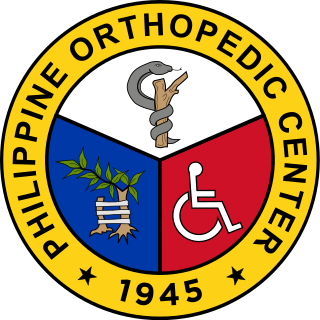
The Philippine Orthopedic Center is a 700 bed tertiary special hospital under the Department of Health of the Philippines. The hospital is located at Banawe Avenue corner Maria Clara Street, Santa Mesa Heights, Quezon City.
Caraga Regional Hospital is located in Surigao City, on the northeastern tip of the Philippine island of Mindanao. The hospital is one of at least three hospitals serving the area. The three all are located within 1 1⁄2 miles (2.4 km) of each other on National Road, which leads from the city proper south to the city airport.

The Dr. Ronald P. Guzman Medical Center Inc. is a Secondary Level Hospital located in Carig, Tuguegarao City, Philippines. It has a bed capacity of 250. It is the first in the Philippines to have a Hitachi brand of X-ray with Digital Radio Fluoroscopy and the first and only magnetic resonance imaging (MRI) Machine in Cagayan Valley Region II. The Main Hospital, also called "The Cross", which is adequately furnished with rooms and wards It is Founded by Dr. Ronald P. Guzman, CEO on October 10, 2010 (10-10-10), who is also the president and founder of Medical Colleges of Northern Philippines and International School of Asia and the Pacific and the Holy Infant Hospital located also in the city.

Relations between the Republic of the Philippines and the People's Republic of China have historically been cordial, but have suffered due to the worsening South China Sea dispute. The current policy of the president of the Philippines aims for remedying relations between the Philippines and China at the expense of the former's relationship with the United States, while the current policy of the president of China aims for greater influence over the Philippines and the region, in general, while combating American influence.

Tuguegarao, officially Tuguegarao City and referred to by locals as Tugue, is a 3rd class component city in the Philippines. It is the capital of the province of Cagayan and the regional and institutional center of Cagayan Valley (Region II). With a population of 153,502, according to the 2015 census, it is a major urban center in the Northeastern Luzon, a primary growth center and one of the fastest growing cities in the Philippines.

Mactan–Cebu International Airport located in Central Visayas region, is the second busiest international airport in the Philippines that serves Cebu City and its metropolitan area as well as the Central Visayas. It is located in Lapu-Lapu City on Mactan Island, a part of Metro Cebu. The airport is managed by the Mactan–Cebu International Airport Authority. It is the world’s first international resort airport and is the main base of Cebu Pacific, Pan Pacific Airlines, and Royal Air Philippines. It covers an area of 797 hectares.
DuterteNomics is a catch-all term referring to the socioeconomic policies of President Rodrigo Duterte. A significant part of the policy includes the development of infrastructure and industries.
The Northern Mindanao Wellness and Reintegration Center (NMWRC) is a drug rehabilitation facility in Malaybalay, Bukidnon, Philippines.
Marquez "Mark" Ocampo Go is a Filipino businessman and politician. A member of the Nacionalista Party, he is the incumbent representative of the legislative district of Baguio since 2016. He is also an outstanding citizen of Baguio awardee in 1998.


